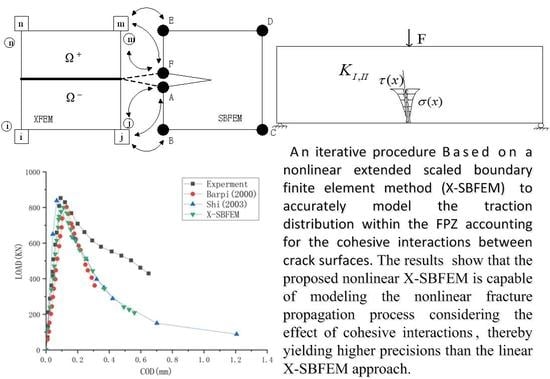A Nonlinear Crack Model for Concrete Structure Based on an Extended Scaled Boundary Finite Element Method
Abstract
1. Introduction
2. Extended Scaled Boundary Finite Element Method
2.1. Extended Finite Element Method
2.2. Scaled Boundary Finite Element Method
2.3. Force Balance and Displacement Coordination
3. A Nonlinear Crack Model with Iterative Method for Cohesive Interactions in the FPZ
- Assume that the structure is only affected by the external force so that the relative displacement of the super-element crack surface can be obtained based on the linear elastic assumptions of X-SBFEM, and that the corresponding cohesive traction can be obtained according to Figure 5.
- As shown in Figure 6, the external force and the cohesive force obtained in the previous step are applied to the structure, wherein the cohesive traction is applied in the form of a side-face force, formulated in accordance to the following equation:where
- C.
- Repeat the steps until the relationship between and becomes consistent with the pattern of variation plotted in Figure 5.
4. Numerical Examples
4.1. A Three-Point Bending Beam
4.2. A Four-Point Shear Beam
4.3. An Experimental Concrete Gravity Dam with Single-Crack Expansion
4.4. Static Cohesive Crack Propagation Simulation of Koyna Dam
5. Conclusions
- (1)
- A nonlinear X-SBFEM model using the linear superposition of the iterative method was developed and validated to include the cohesive tractions and the fracture energy from FPZ.
- (2)
- The proposed model can be applied to complex structures without inserting CIEs.
- (3)
- The accuracy of the proposed model was in close agreement with the experiments showing improvement over the linear SBFEM method.
- (4)
- The numerical procedure is easily implemented within the finite element method software and can be compatible with various nonlinear constitutive relations.
Author Contributions
Acknowledgments
Conflicts of Interest
References
- Bazant, Z.P.; Cedolin, L. Blunt crack band propagation in finite element analysis. J. Eng. Mech. Div. 1979, 105, 297–315. [Google Scholar]
- Rashid, Y.R. Analysis of prestressed concrete pressure vessels. Nucl. Eng. Des. 1968, 7, 334–344. [Google Scholar] [CrossRef]
- Bhattacharjee, S.S.; Leger, P. Seismic cracking and energy dissipation in concrete gravity dams. Earthq. Eng. Struct. Mech. 1993, 22, 991–1007. [Google Scholar] [CrossRef]
- Calayir, Y.; Karaton, M. Seismic fracture analysis of concrete gravity dams including dam-reservoir interaction. Comput. Struct. 2005, 83, 1595–1606. [Google Scholar] [CrossRef]
- Cai, Q.; Robberts, J.M.; van Rensburg, B.W.J. Finite element fracture modeling of concrete gravity dams. J. S. Afr. Inst. Civ. Eng. 2008, 50, 13–24. [Google Scholar]
- Bazant, Z.P.; Planas, J. Fracture and Size Effect in Concrete and Other Quasibrittle Materials; CRC Press: Boca Raton, FL, USA, 1998. [Google Scholar]
- Dugdale, D.S. Yielding of steel sheets containing slits. J. Mech. Phys. Solids 1960, 8, 100–104. [Google Scholar] [CrossRef]
- Barenblatt, G.I. The mathematical theory of equilibrium crack in the brittle fracture. Adv. Appl. Mech. 1962, 7, 100–104. [Google Scholar]
- Hillerborg, A.; Modéer, M.; Petersson, P.E. Analysis of crack formation and crack growth in concrete by means of fracture mechanics and finite elements. Cem. Concr. Res. 1976, 6, 773–782. [Google Scholar] [CrossRef]
- Skrikerud, P.E.; Bachmann, H. Discrete crack modeling for dynamically loaded, unreinforced concrete structures. Earthq. Eng. Struct. Dyn. 1986, 14, 297–315. [Google Scholar] [CrossRef]
- Ayari, L.M.; Saouma, V.E. A fracture mechanics based seismic analysis of concrete gravity dams using discrete cracks. Eng. Fract. Mech. 1990, 35, 587–598. [Google Scholar] [CrossRef]
- Yang, Z.J.; Chen, J.F. Finite element modelling of multiple discrete cohesive crack propagation in reinforced concrete beams. Eng. Fract. Mech. 2005, 72, 280–297. [Google Scholar] [CrossRef]
- Xie, M.; Gerstle, W.H. Energy-based cohesive crack propagation modelling. ASCE J. Eng. Mech. 1995, 121, 1349–1458. [Google Scholar] [CrossRef]
- Yang, Z.J.; Chen, J.F. Fully automatic modelling of cohesive discrete crack propagation in concrete beams using local arc-length methods. Int. J. Solids Struct. 2004, 41, 801–826. [Google Scholar] [CrossRef]
- Benkemoun, N.; Poullain, P.; Al Khazraji, H.; Choinska, M.; Khelidj, A. Meso-scale investigation of failure in the tensile splitting test: Size effect and fracture energy analysis. Eng. Fract. Mech. 2016, 168, 242–259. [Google Scholar] [CrossRef]
- Grassla, P.; Jirásek, M. Meso-scale approach to modelling the fracture process zone of concrete subjected to uniaxial tension. Int. J. Solids Struct. 2010, 47, 957–968. [Google Scholar] [CrossRef]
- Mai, N.T.; Phi, P.Q.; Nguyen, V.P.; Choi, S.T. Atomic-scale mode separation for mixed-mode intergranular fracture in polycrystalline metals. Theor. Appl. Fract. Mech. 2018, 96, 45–55. [Google Scholar] [CrossRef]
- Mai, N.T.; Choi, S.T. Atomic-scale mutual integrals for mixed-mode fracture: Abnormal fracture toughness of grain boundaries in grapheme. Int. J. Solids Struct. 2018, 138, 205–216. [Google Scholar] [CrossRef]
- Rabczuk, T.; Bordas, S.; Zi, G. On three-dimensional modelling of crack growth using partition of unity methods. Comput. Struct. 2009, 88, 1391–1411. [Google Scholar] [CrossRef]
- Belytschko, T.; Gracie, R.; Ventura, G. A review of extended/generalized finite element methods for material model. Model. Simul. Mater. Sci. Eng. 2009, 17, 1–24. [Google Scholar] [CrossRef]
- Song, C.M.; Wolf, J.P. Semi-analytical representation of stress singularities as occurring in cracks in anisotropic multi-materials with the scaled boundary finite element method. Comput. Struct. 2002, 80, 183–197. [Google Scholar] [CrossRef]
- Song, C.M.; Francis, T.; Wei, G. A definition and evaluation procedure of generalized stress intensity factors at cracks and multi-material wedges. Eng. Fract. Mech. 2010, 72, 2316–2336. [Google Scholar] [CrossRef]
- Li, J.; Fu, X.; Chen, B.; Wu, C.; Lin, G. Modeling crack propagation with the extended scaled boundary finite element method based on the level set method. Comput. Struct. 2016, 167, 50–68. [Google Scholar] [CrossRef]
- Ooi, E.T.; Song, C.M.; Tin-Loi, F.; Yang, Z.J. Automatic modelling of cohesive crack propagation in concrete using polygon scaled boundary finite elements. Eng. Fract. Mech. 2012, 93, 13–33. [Google Scholar] [CrossRef]
- Huang, R.; Sukumar, N.; Prevost, J.H. Modelling quasi-static crack growth with the extended finite element method part I: Computer implementation. Int. J. Solids Struct. 2003, 40, 7513–7539. [Google Scholar] [CrossRef]
- Huang, R.; Sukumar, N.; Prevost, J.H. Modelling quasi-static crack growth with the extended finite element method part II: Numerical applications. Int. J. Solids Struct. 2003, 40, 7539–7552. [Google Scholar] [CrossRef]
- Natarajan, S.; Song, C. Representation of singular fields without asymptotic enrichment in the extended finite element method. Int. J. Numer. Meth. Eng. 2013, 96, 813–841. [Google Scholar] [CrossRef]
- Yang, Z.J. Fully automatic modeling of mixed-mode crack propagation using scaled boundary finite element method. Eng. Fract. Mech. 2006, 73, 1711–1731. [Google Scholar] [CrossRef]
- Xu, S.; Reinhardt, H.W. Determination of double-K criterion for crack propagation in quasi-brittle fracture. Part II: Analytical evaluating and practical measuring methods for three-point bending notched beams. Int. J. Fract. 1999, 98, 151–177. [Google Scholar] [CrossRef]
- Petersson, P.E. Crack Growth and Development of Fracture Zone in Plain Concrete and Similar Materials; Report TVBM-1006; Lund Institute of Technology: Lund, Sweden, 1981. [Google Scholar]
- Arrea, M.; Ingraffea, A.R. Mixed-Mode Crack Propagation in Mortar and Concrete; Department of Structural Engineering, Cornell University: Ithaca, NY, USA, 1982. [Google Scholar]
- Carpinteri, A. Size Effects on Strength, Toughness, and Ductility. J. Eng. Mech. 1989, 115, 1375–1392. [Google Scholar] [CrossRef]
- Barpi, F.; Valente, S. Numerical Simulation of Prenotched Gravity Dam Models. J. Eng. Mech. 2000, 126, 611–619. [Google Scholar] [CrossRef]
- Shi, M.; Zhong, H.; Ooi, E.T.; Zhang, C.; Song, C. Modelling of crack propagation of gravity dams by scaled boundary polygons and cohesive crack model. Int. J. Fract. 2013, 183, 29–48. [Google Scholar] [CrossRef]
- Gioia, G.; Bazant, Z.; Pohl, B.P. Is no-tension dam design always safe?—A numerical study. Dam Eng. 1992, 3, 23–34. [Google Scholar]
- Bhattacharjee, S.S.; Léger, P. Application of NFEM models to predict cracking in concrete gravity dams. J. Struct. Eng. 1994, 120, 1255–1271. [Google Scholar] [CrossRef]
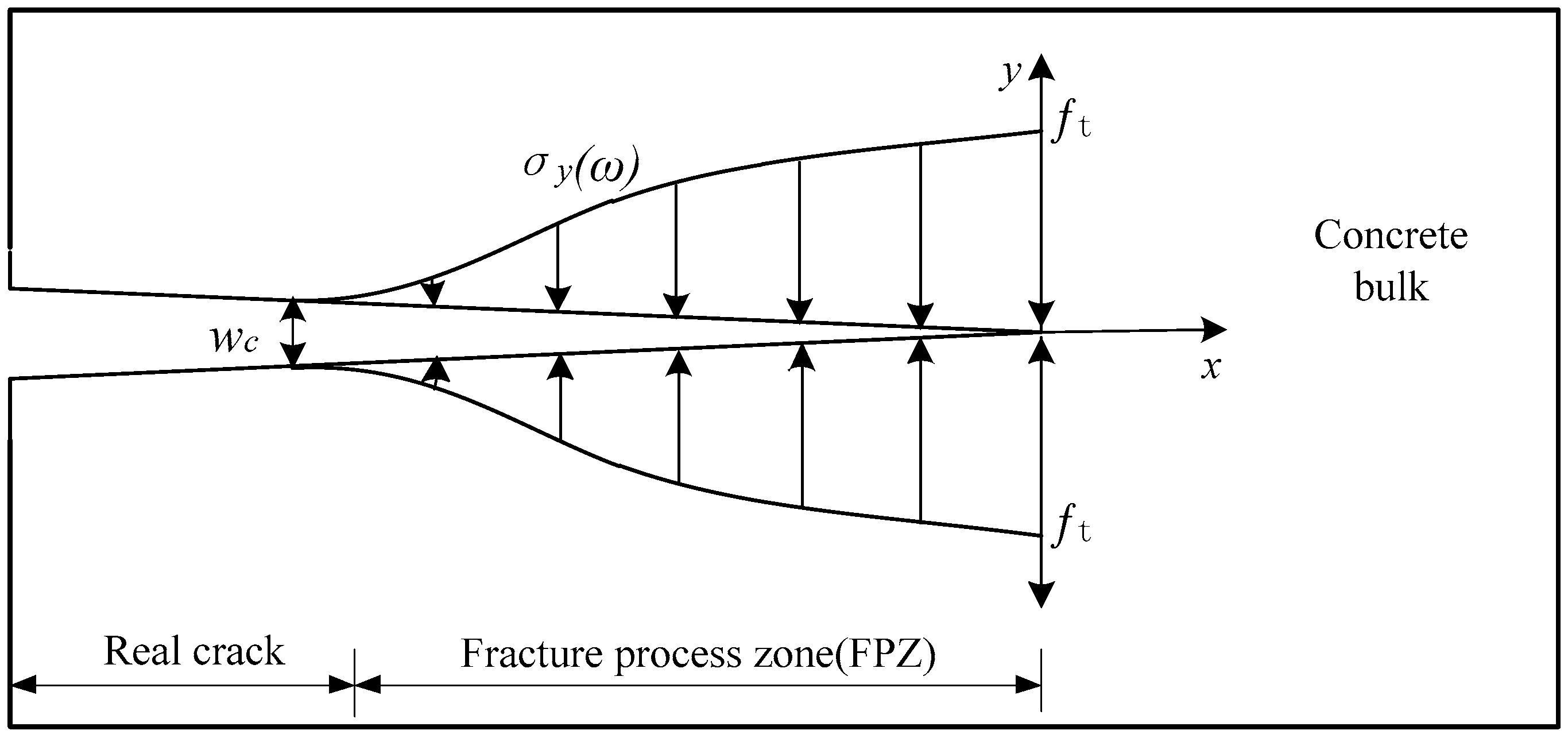

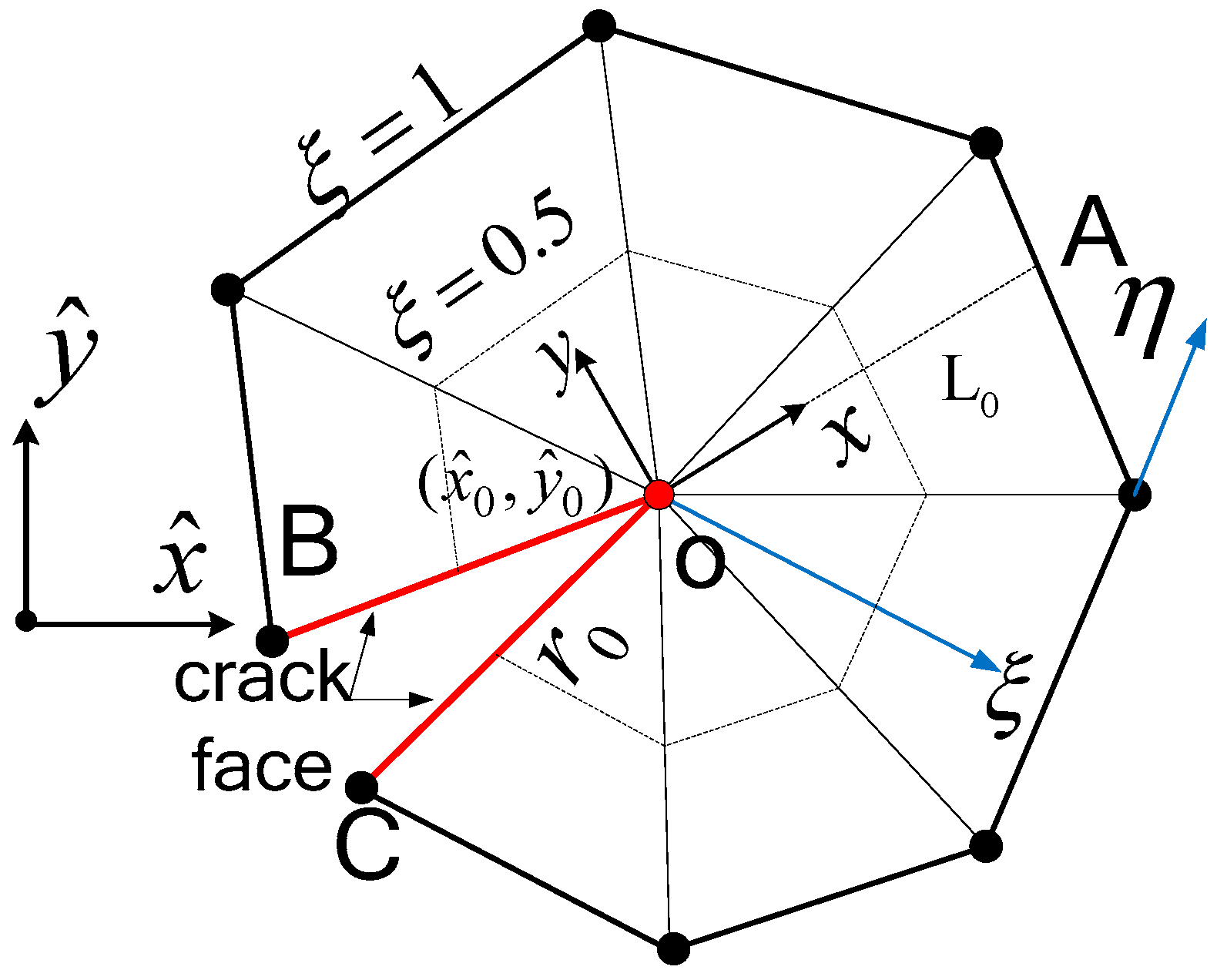

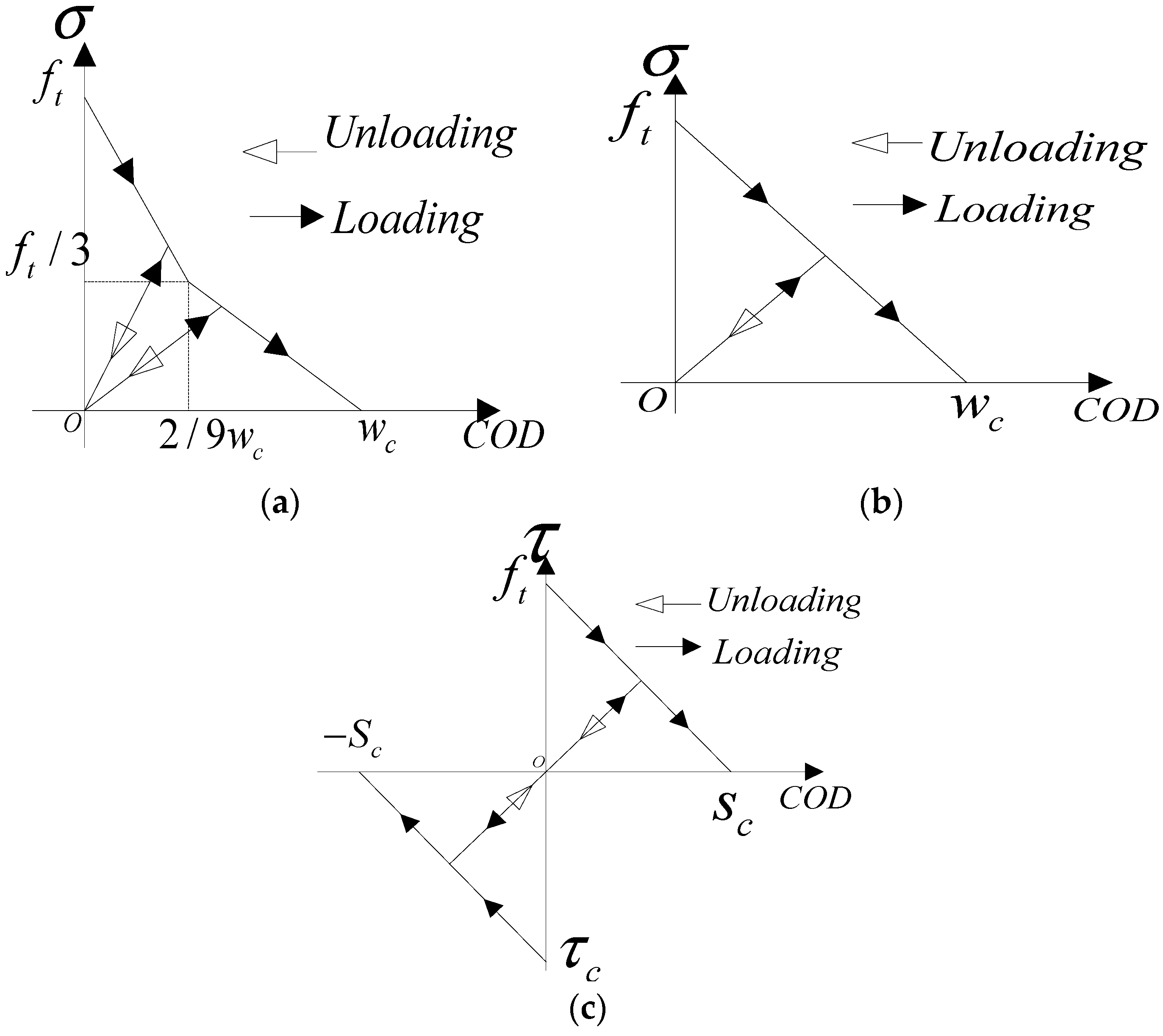

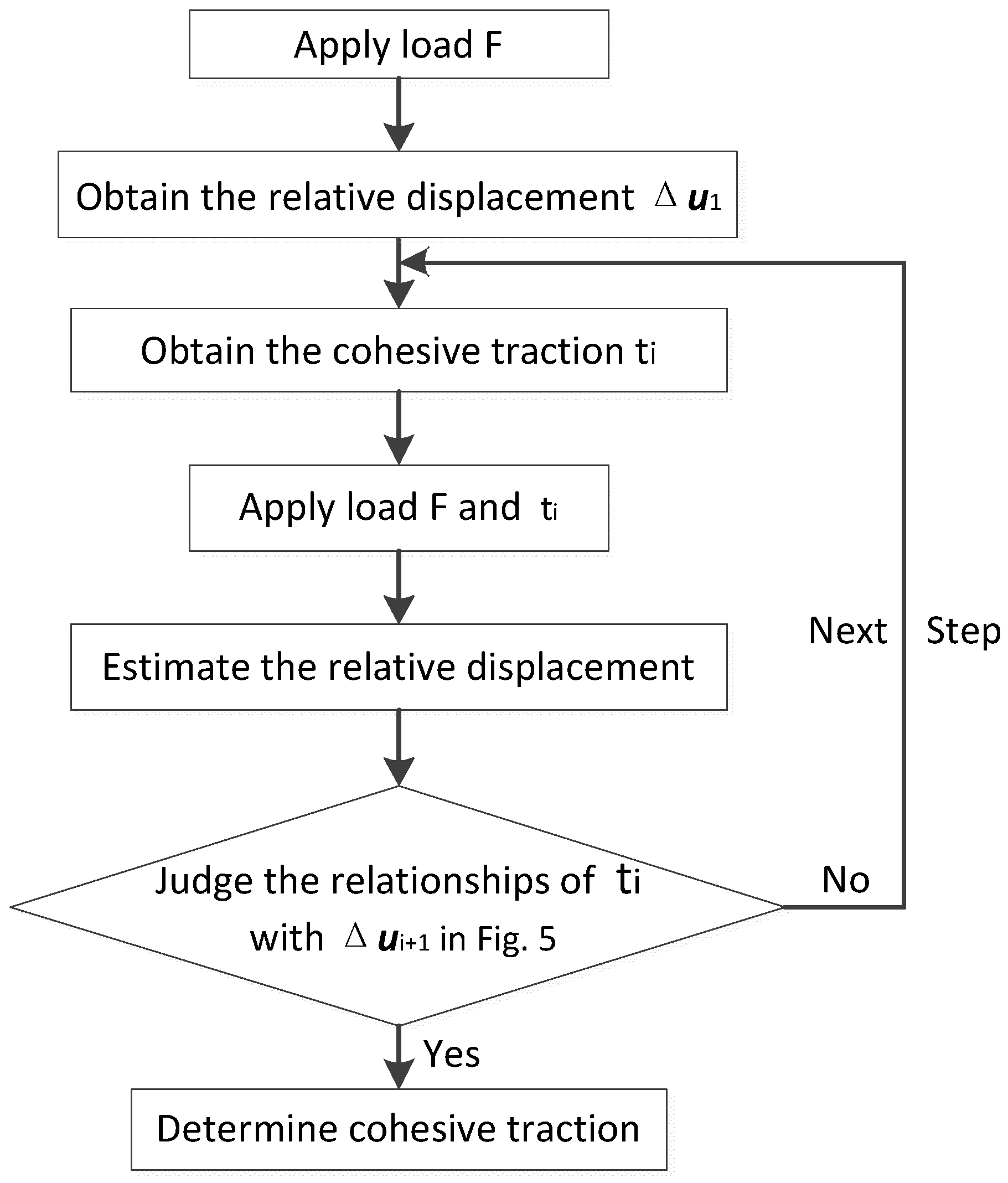
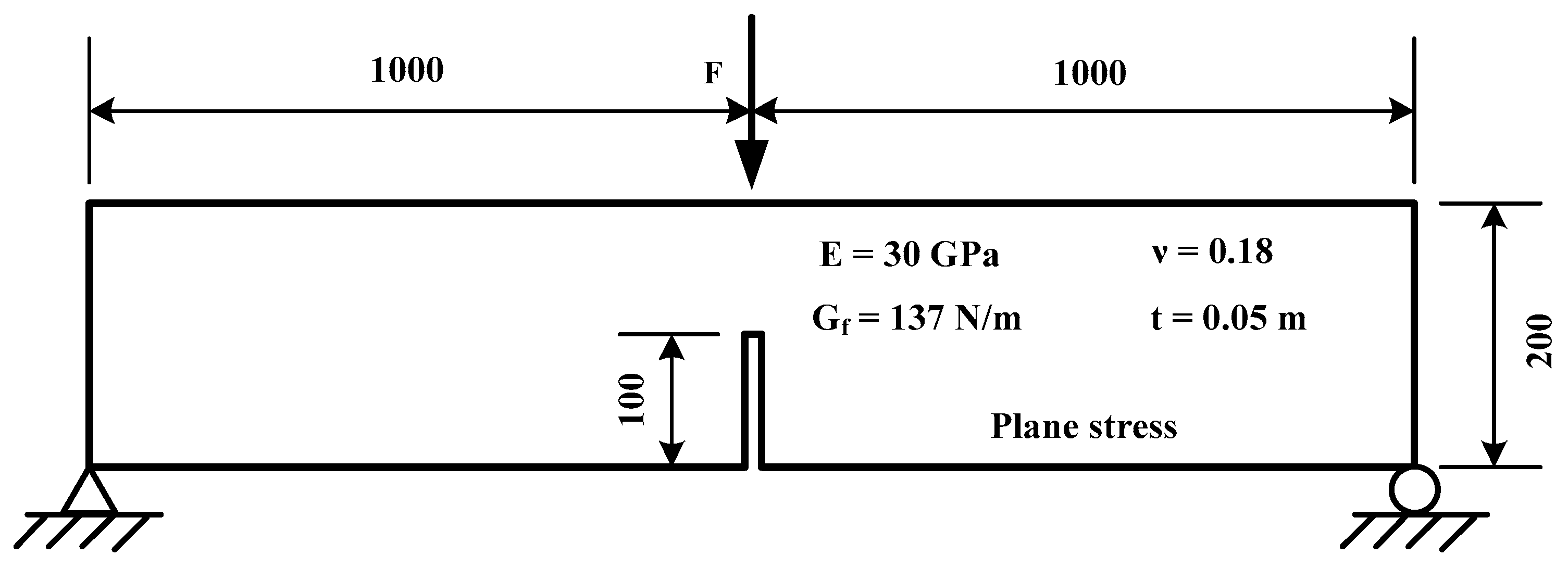
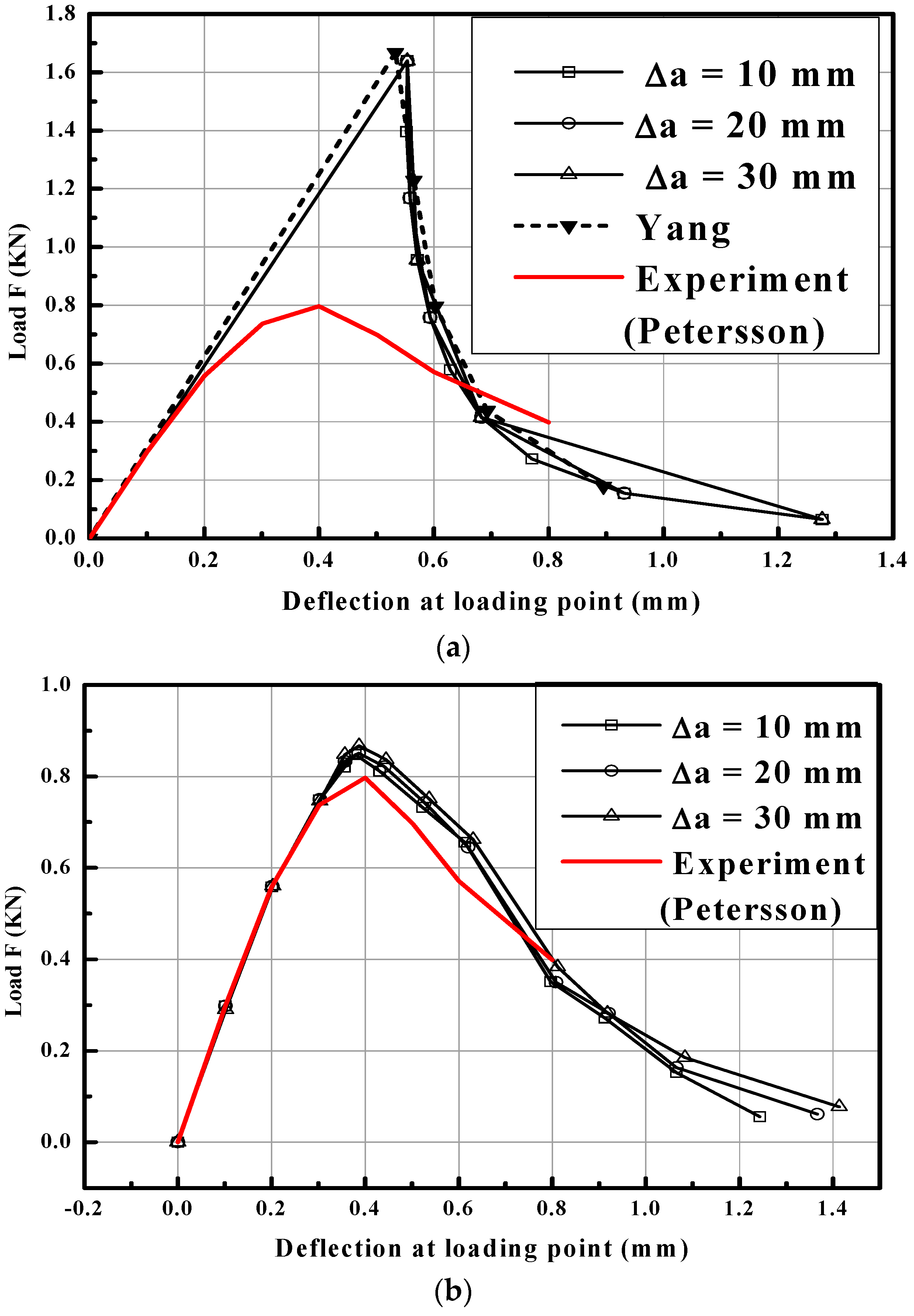

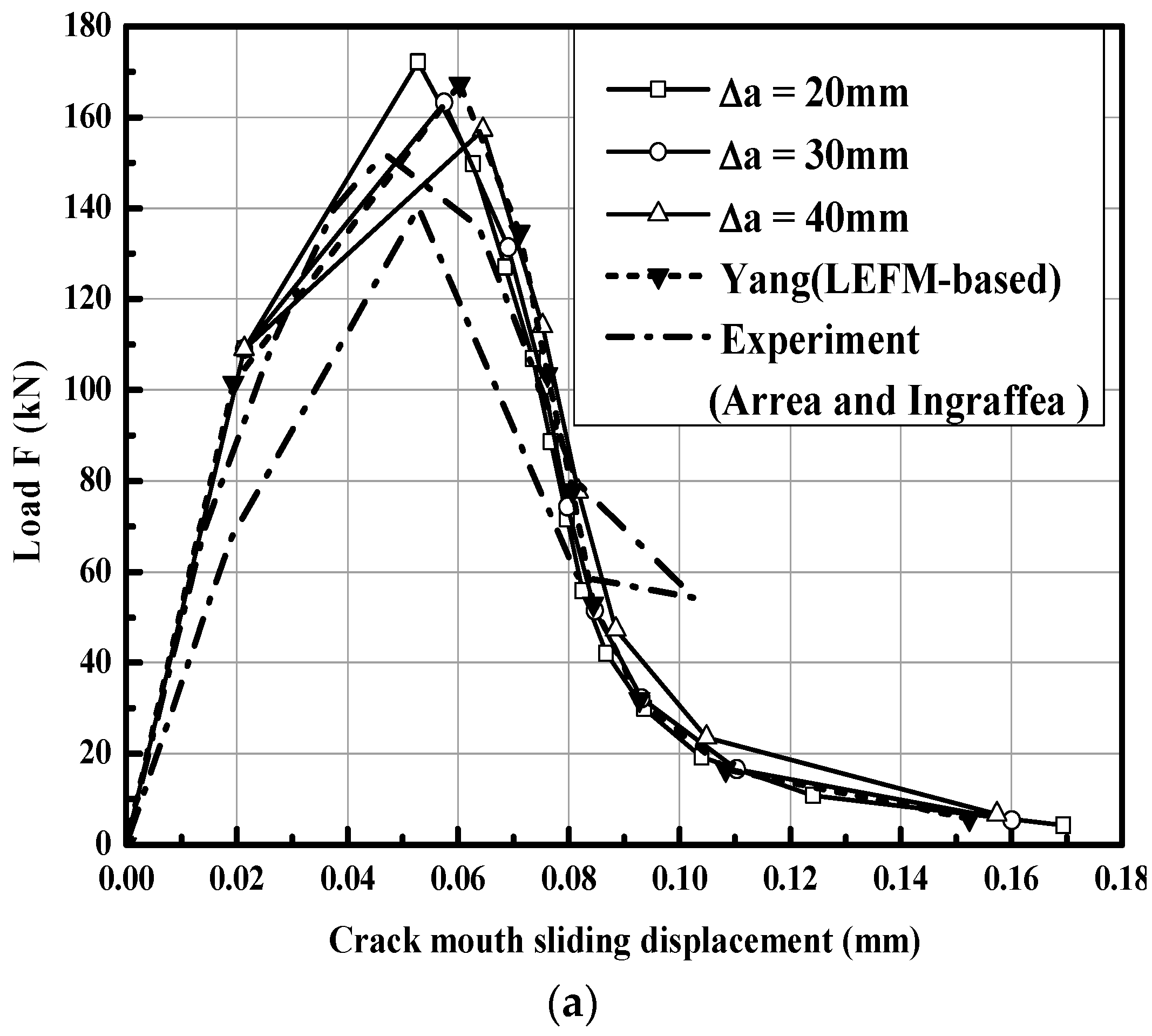
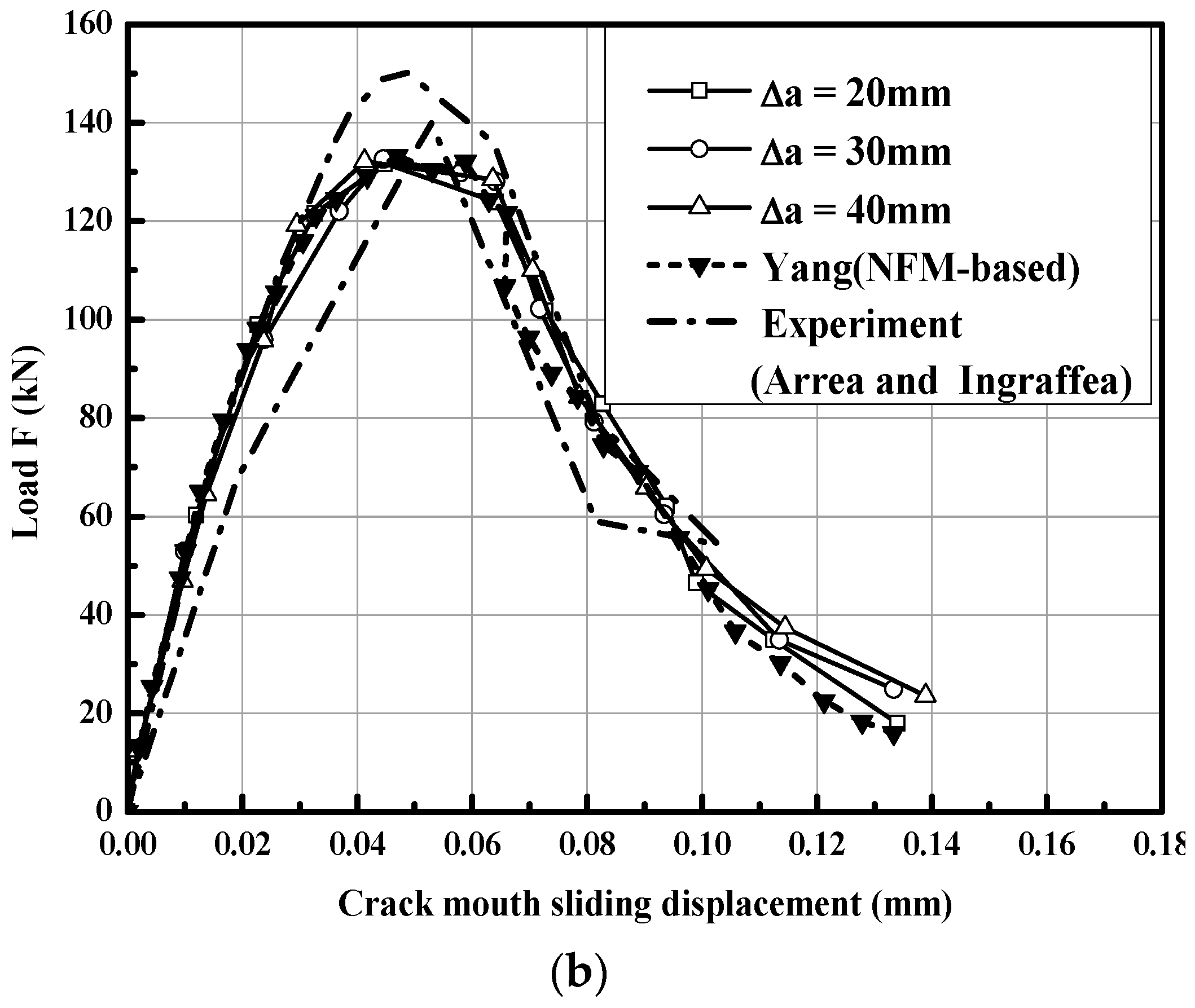

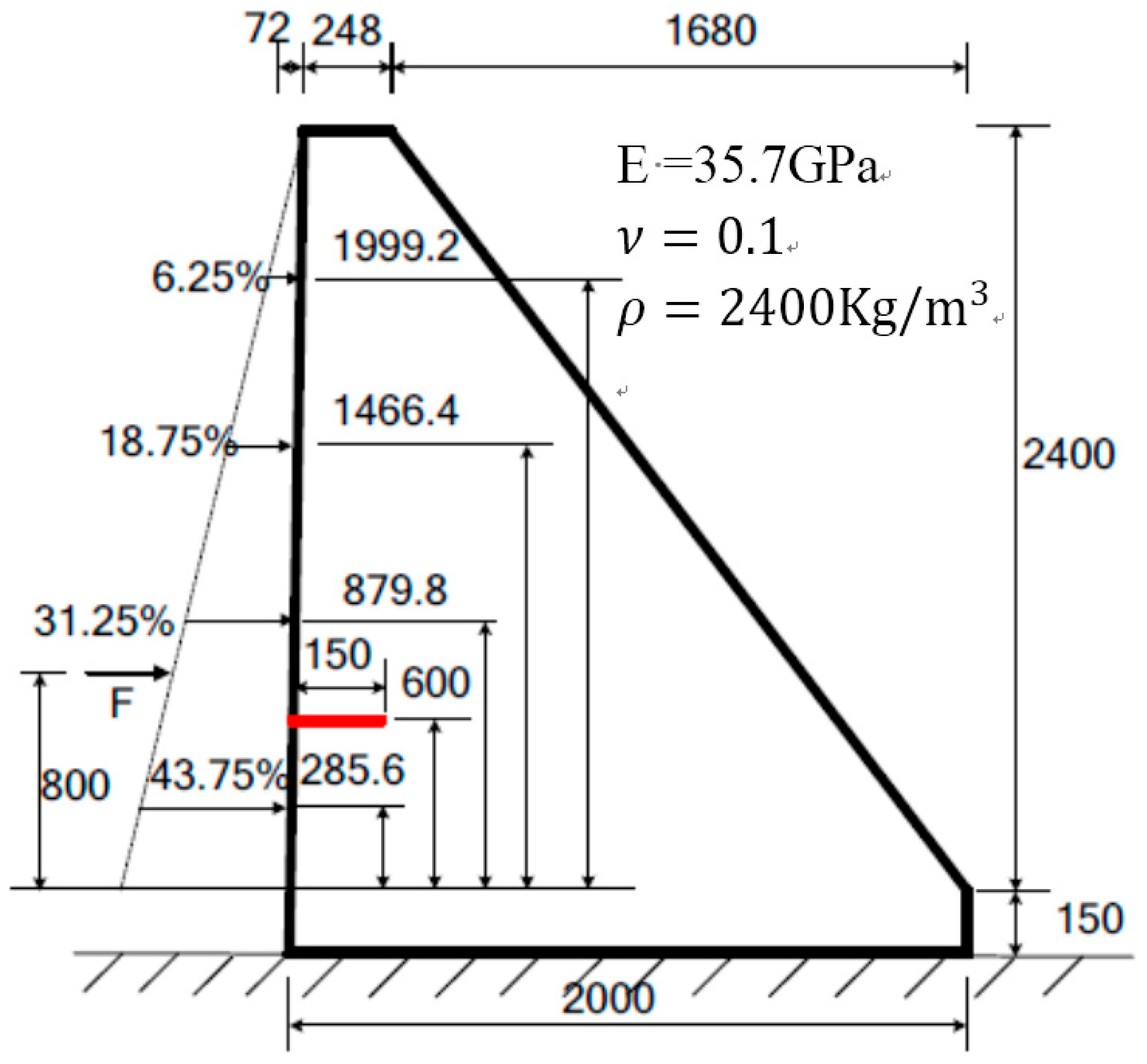
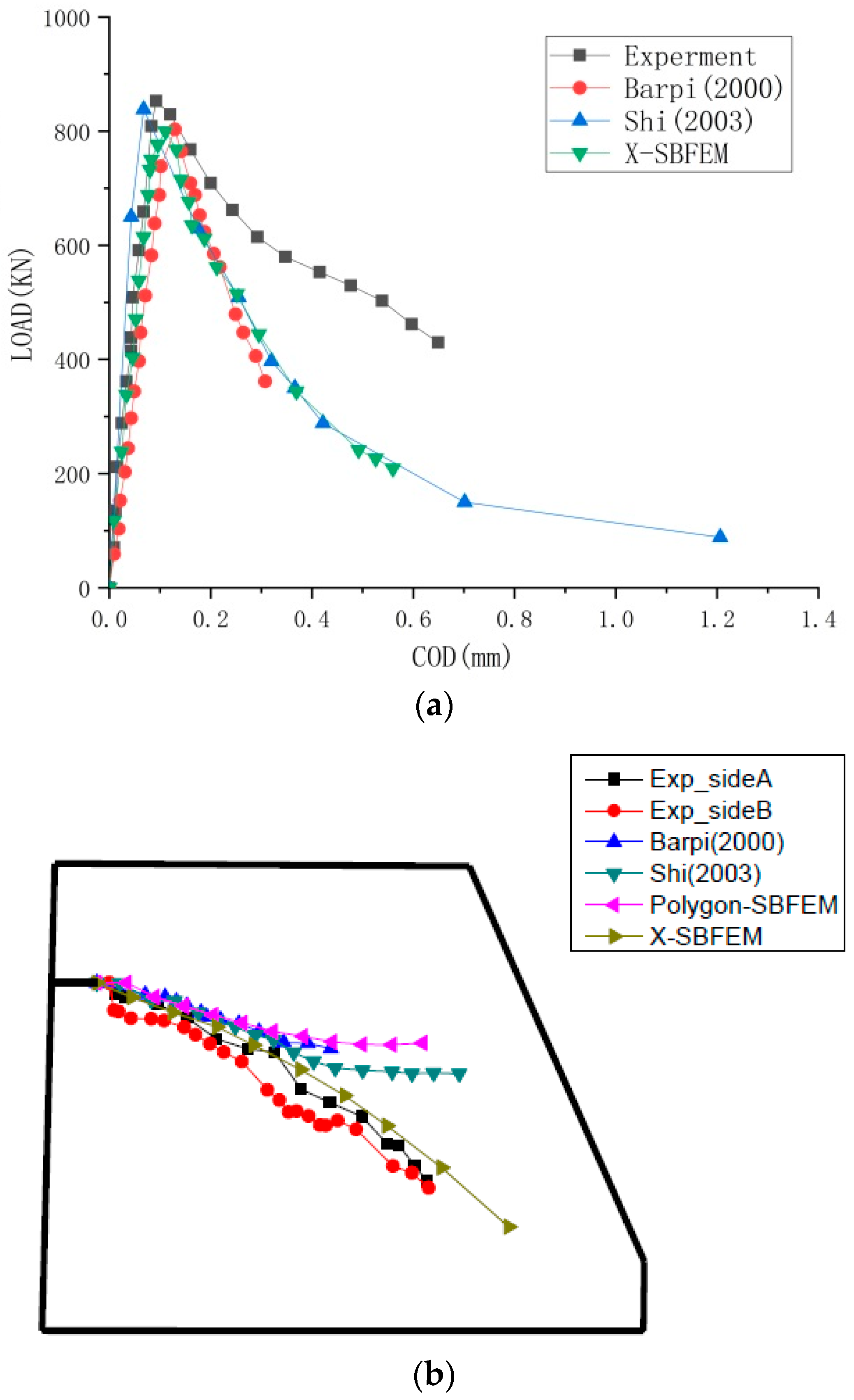
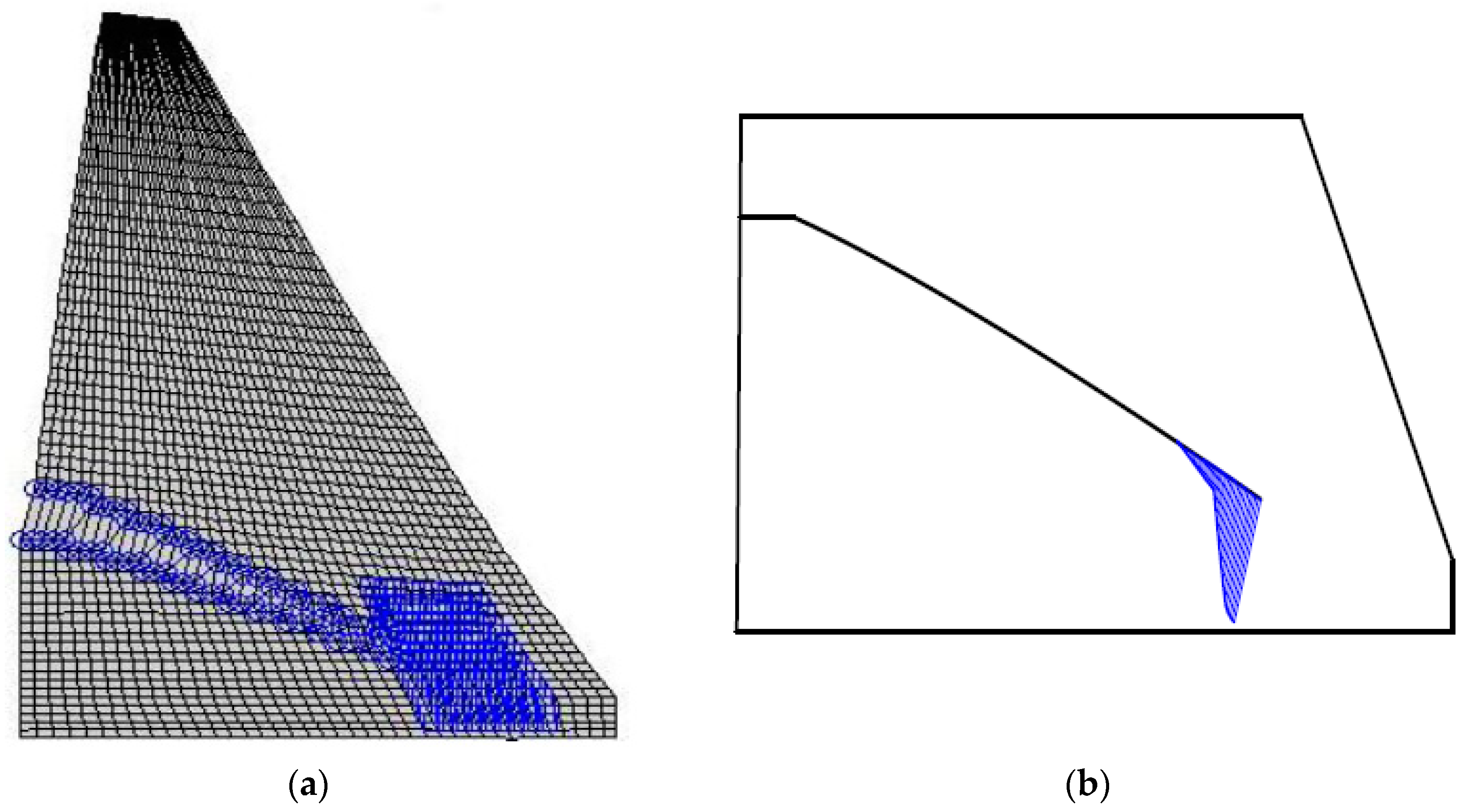
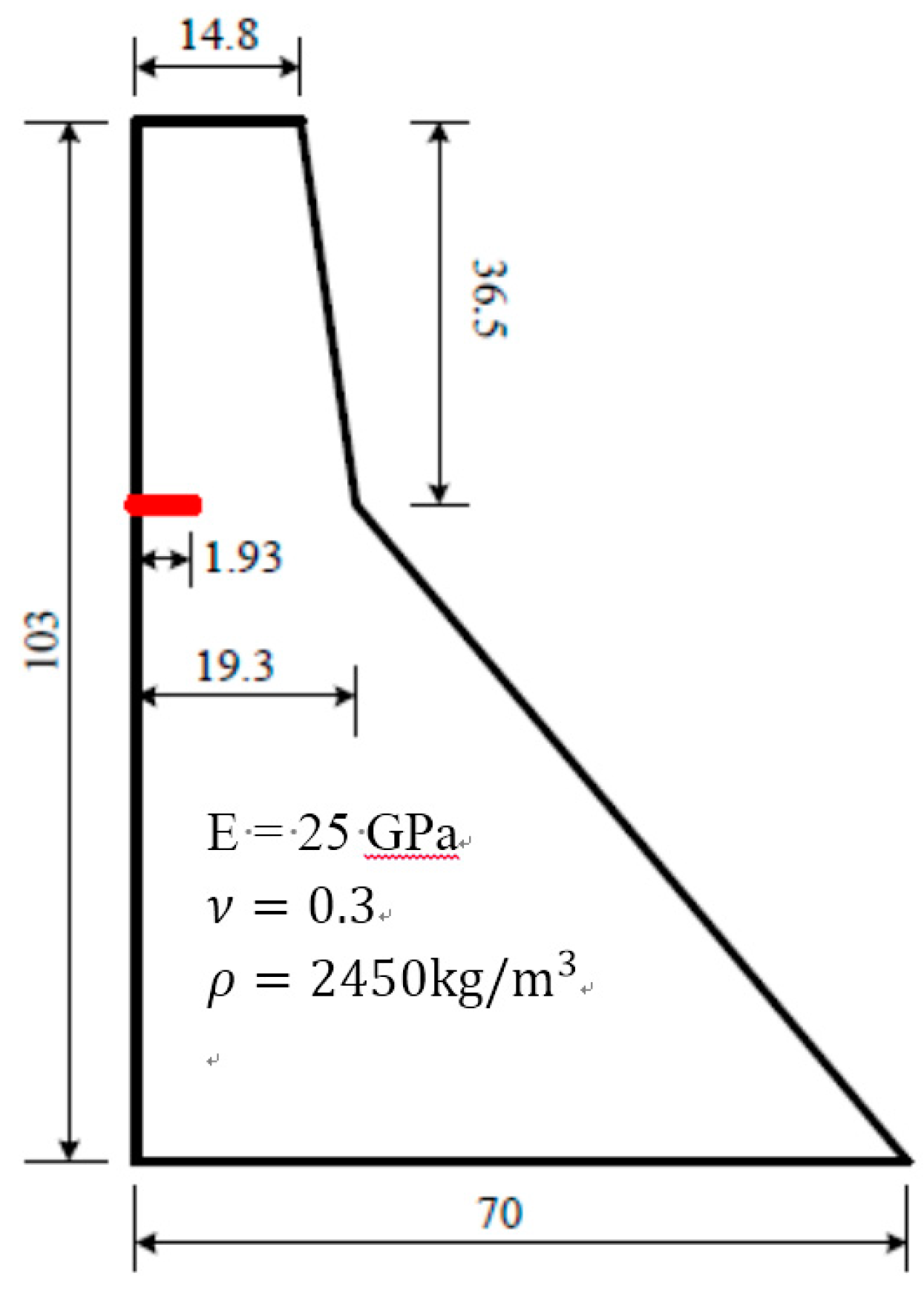
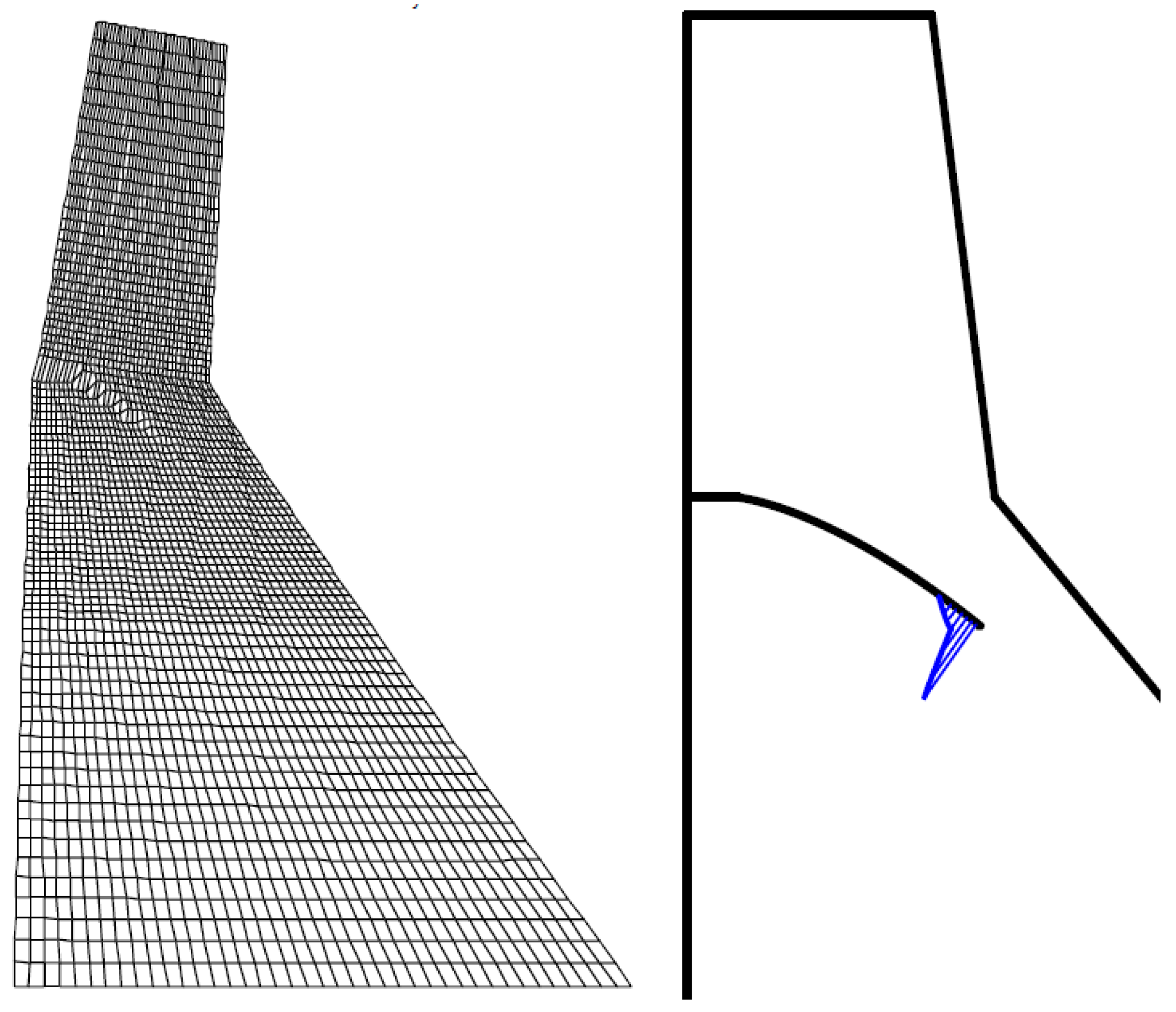
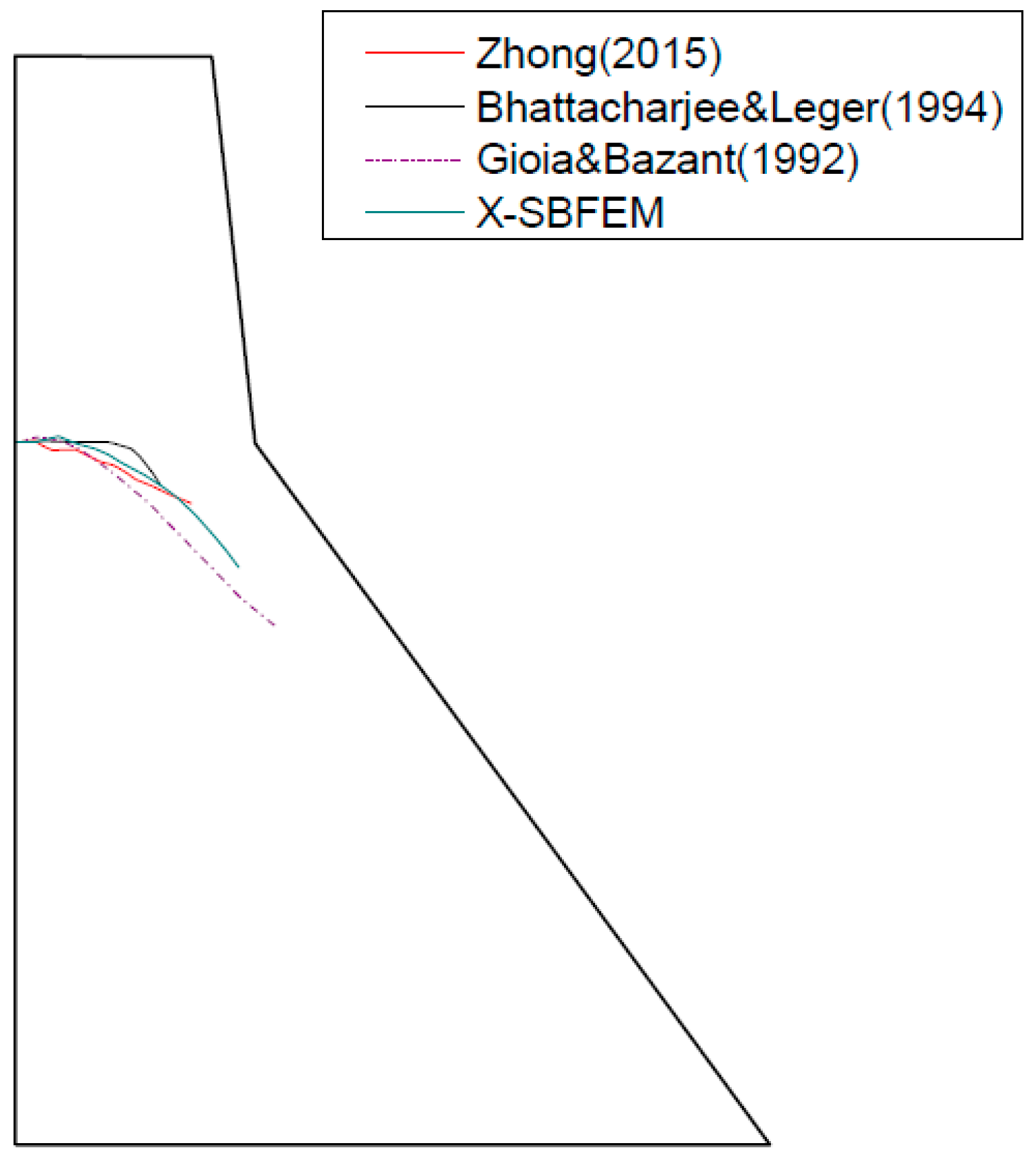
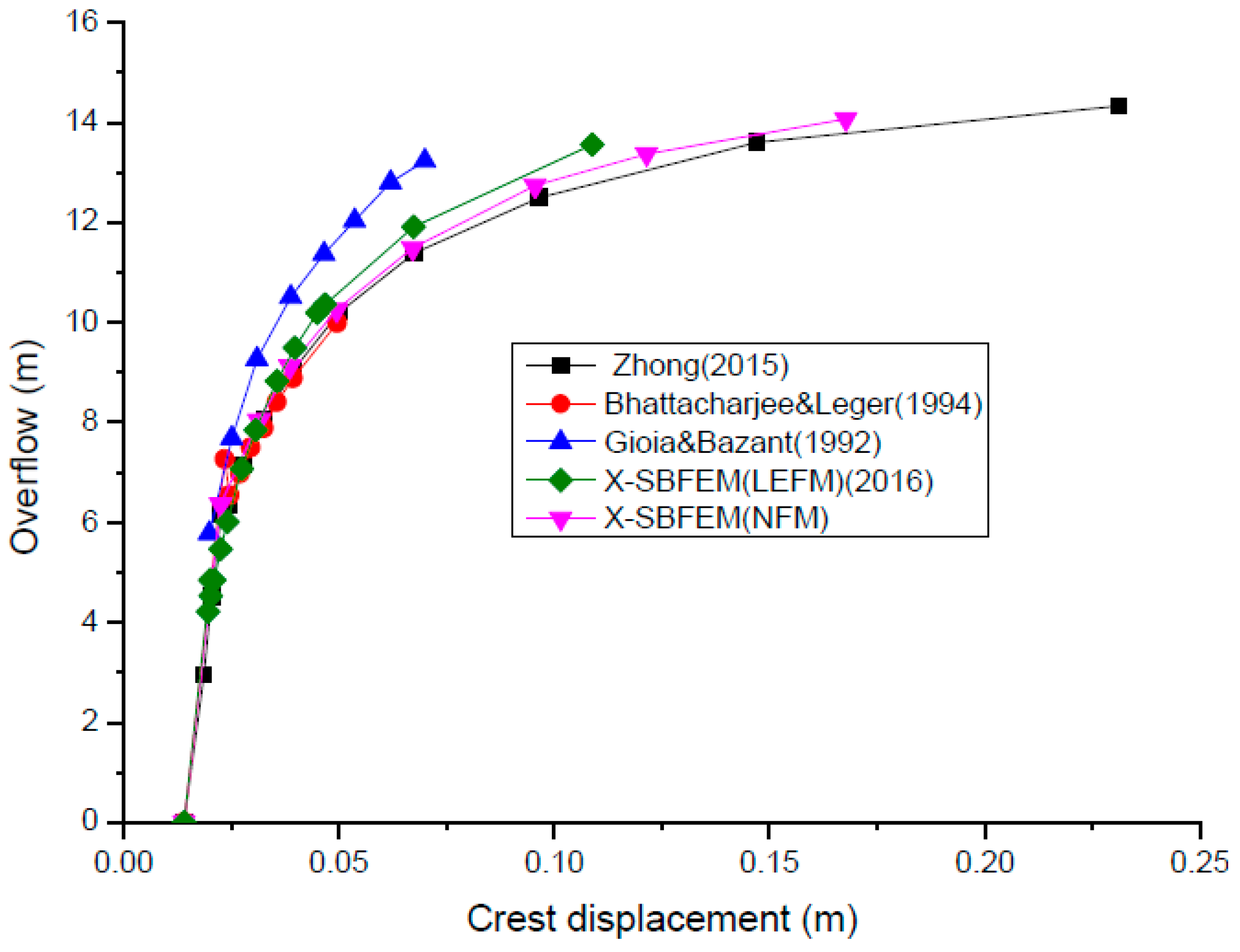
© 2018 by the authors. Licensee MDPI, Basel, Switzerland. This article is an open access article distributed under the terms and conditions of the Creative Commons Attribution (CC BY) license (http://creativecommons.org/licenses/by/4.0/).
Share and Cite
Li, J.-b.; Gao, X.; Fu, X.-a.; Wu, C.; Lin, G. A Nonlinear Crack Model for Concrete Structure Based on an Extended Scaled Boundary Finite Element Method. Appl. Sci. 2018, 8, 1067. https://doi.org/10.3390/app8071067
Li J-b, Gao X, Fu X-a, Wu C, Lin G. A Nonlinear Crack Model for Concrete Structure Based on an Extended Scaled Boundary Finite Element Method. Applied Sciences. 2018; 8(7):1067. https://doi.org/10.3390/app8071067
Chicago/Turabian StyleLi, Jian-bo, Xin Gao, Xing-an Fu, Chenglin Wu, and Gao Lin. 2018. "A Nonlinear Crack Model for Concrete Structure Based on an Extended Scaled Boundary Finite Element Method" Applied Sciences 8, no. 7: 1067. https://doi.org/10.3390/app8071067
APA StyleLi, J.-b., Gao, X., Fu, X.-a., Wu, C., & Lin, G. (2018). A Nonlinear Crack Model for Concrete Structure Based on an Extended Scaled Boundary Finite Element Method. Applied Sciences, 8(7), 1067. https://doi.org/10.3390/app8071067




